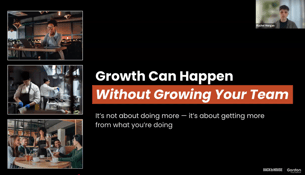Rahul Vinod and Sahil Rahman grew up running around Indian restaurants. Shortly after moving from India to the U.S., their fathers joined together to open Bombay Bistro, which remains a staple of the Washington D.C. area now 30 years later.
Vinod and Rahman quickly grew to become best friends. And since their teenage years, they’ve been brainstorming business ideas of opening a restaurant of their own.
“There was this competition in high school, and we both put together a small business plan for an Indian fast-casual spot,” says Vinod, now in his early 30s. “At that time, Chipotle was really starting to make some headway, and we thought, ‘We have rice, beans, chicken – why couldn't we do the same thing?’”
Vinod and Rahman both went off to college, gaining business degrees that ended up steering them far away from the hospitality industry. But that idea of a fast-casual Indian spot never left their minds.
After a handful of years of working in the corporate world, both Vinod and Rahman found themselves looking for a change. Eventually, they decided it was time to put their Indian bowl concept into action, and in 2017, they opened RASA, with a goal of making Indian food more accessible. Five years later, they’re on track to open their fourth location and have recently secured their first Series A funding.
We sat down with Vinod to learn more about the concept, how they’re differentiating themselves in a competitive fast-casual bowl market, and their plans for the future.
You’d essentially been dreaming up RASA since high school. Tell me more about the initial vision.
So we started talking about that idea we first had back in high school, and at this point, we’d really seen Indian culture come a long way over the past 30 years of our lives. Indian culture was permeating America. You were seeing people practicing yoga and meditation, people ordering turmeric lattes, and even when you watched TV, people knew Aziz Ansari and Mindy Kaling. Then you had more and more people now saying, “I’ve tried Indian food and I like it.”
But when we dug further, it was like, “OK, you've tried it and you liked it. How often do you eat it?” And there was always this disconnect, where the answer was usually “once every few months”. That's kind of strange if you like something. So we started by trying to figure out what were those barriers preventing people from eating Indian food more often.
Often, the Indian restaurants that people like or know were out of the way in a random shopping center. There are Taj Mahal paintings on the wall and Indian music playing, so it can feel unfamiliar. And then you sit down, get a copy of the menu, and it has 150 items with names like saag makai that you don’t know. Separately, most of the restaurants at the time were slower, sit-down experiences that weren’t necessarily affordable. So we took each one of those pillars and were like, “How do we flip this?”
And how did you end up weaving that into your final concept?
From a location standpoint, our first restaurant is right next to Nationals Park in Washington D.C., which is the baseball stadium. It’s also in one of the most-growing neighborhoods in the city, in terms of residential and office traffic.
With the design, it was about making a place that feels inviting but still captures the vibrancy of India. We decided any storefront starts with the front door. In Jeypore in India, they have a ton of palaces that have these giant, ornamental doors, which are just really stunning. Sahil’s aunt in Delhi has her own furniture company, so she actually made this 15-foot-tall, bright blue door that now welcomes you into the restaurant. Then we came up with a number of design elements to lead people in. For example, at our first location, we have these colorful strings that we run across the ceiling, back and forth through each side, to lead you through the space.
Then when it came to the menu, we tried to add more transparency through being thoughtful about naming. So instead of calling things saag makai, we called it sautéed spinach, just because more people can understand that.
Ultimately you decided to go with the bowl concept. Can you share the strategy behind that?
We saw the success of Chipotle, Cava, Sweetgreen, brands like that. But we also specifically chose to have that assembly line model because we really want people to see the ingredients and the food being prepared right in front of them, and be able to choose that way. That way there’s no mystery. You choose your protein separately, and then you add a sauce separately.
From a cost perspective, we felt that fast-casual was the way to go. It's more accessible for people to try the food more than once versus having to shell out $50 for a meal. And when people like to enjoy Indian food they don’t usually get one dish. So it was like, how do we allow people to taste all those flavors together, but in a way where they don’t have to order six different entrees?’
Are there any specific strategies you guys are taking to stand out in the bowl market, given the competition in the space?
Just having the Indian cuisine is definitely a differentiator. But that’s more about trying to introduce people to these flavors that we grew up with and that we love.
American taste buds are changing – you’re seeing this across the country. If you think about 15 years ago, no one knew what hummus was. And now it’s become so much more mainstream. The same thing is happening with spice. You get fast food and they have Sriracha-spiced chicken wings. People are looking for more food with more flavor. We’re trying to lean into that, and at the same time, still offer that healthful experience that people get when they eat at a Sweetgreen or Cava.
With rising food costs, have you had any troubles staying in the $10-$12 range?
We wanted to bring the best aspects of food in terms of quality and where we’re sourcing from, and we’ve still been able to deliver that. But given the current supply chain issues and the war in Ukraine, it is becoming exceedingly hard at a small scale to absorb all of these prices. In fast casual, we’re a little stuck. If you’re a fine-dining restaurant and were charging $25 for an entree and you go up to $30, people might understand. But if you’re fast-casual, you can’t charge $18 for a lunch bowl. We haven’t had to make any changes yet, but it’s something we continue to evaluate.
We use sunflower oil, and 50% of the world’s sunflower oil comes from Ukraine. One of our vendors was saying, “I can’t get this for you until the summer.” So now we’re looking for alternatives. It’s been a constant challenge, which I’m sure any restaurant would tell you a similar story.
You recently raised a Series A of funding – I imagine the plan was always to scale RASA?
We went in with the goal of scaling, and we were pretty lucky. The D.C. hospitality community, as well as the overall fast-casual community, has been really warm and welcoming to us. We had the opportunity early on to speak with a lot of the industry leaders and get advice on how to grow.
We’d done more of a family-friends angel round to start. We followed a similar path to open our second and third locations. And then we met Rellevant Partners kind of by chance. One of the partners, her son was interning for the Nationals. He’d come eat at RASA all the time, and said, “Hey mom, you have to check out this place.”
They’ve been really good partners for us. They see the vision the same way we do, and they also understood that COVID sucked for restaurants. It’s really about finding the right partner, so we were lucky in the sense that we found people we trust and are excited to do business with.
Do you have any advice for other operators who are looking at how to raise their own funding?
It’s tough raising money – there’s no doubt about that. We really try to channel both of our networks. In the early days, we’d just show up to random networking events in the city where we thought rich people would be, and we’d talk about our vision.
Once we had our first spot open, then we could bring people to experience it. We had investors come early on as guests, enjoy the experience, and want to get involved from an investment standpoint. So I think the lesson from that is to just focus on what you really want from the beginning and make sure it's a place you're going to be proud of, and hopefully that can attract further investment.
What role have your fathers played in getting RASA off the ground?
We wouldn’t be where we are without them. Their oldest restaurant just celebrated 30 years this January, and their other restaurant is 19 years old. Most restaurants don’t last that long. Having that kind of history really was instrumental to our success.
Both my dad and Sahil’s dad are still best friends and business partners, which is just admirable. One of the biggest reasons restaurants fail is because there’s a fight between the partners. We had a good example to learn from. But also from the culinary side, my dad helped us create all of the recipes at RASA. We spent a year working in our fathers’ existing restaurants, starting from the basics with hours of slicing onions, until we could cook everything in the restaurant confidently.
And then it’s a small community here – having them in the D.C. area did give us a sense of credibility from the beginning. We had some of our initial pitch meetings in their restaurants.
Where do you guys see yourself moving in the future?
In the short term, we’re focused on the D.C., Maryland, and Virginia area. We’re opening our fourth location this summer in the Fairfax area, and that will be our first true suburban location. But we both lived and worked in New York and are definitely drawn to the appeal of New York City, and are looking at other cities, whether that be in Philly or North Carolina. I don’t think we’re quite there yet. We’re trying to stay focused on growing our team and making an impact in the DMV.
Grace Dickinson is a reporter at Back of House. Send tips or inquiries to grace@backofhouse.io.





